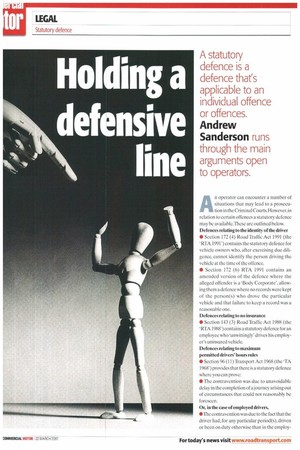A statutory defence is a defence that's applicable to an individual offence or offences.
Page 38

Page 39

If you've noticed an error in this article please click here to report it so we can fix it.
Andrew
Sanderson runs
through the main arguments open to operators.
An operator can encounter a number of situations that may lead to a prosecution in the Criminal Courts.However,in relation to certain offences a statutory defence may be available.These are outlined below. Defences relating to the identity of the driver • Section 172 (4) Road Traffic Act 1991 (the `RTA 1991') contains the statutory defence for vehicle owners who, after exercising due diligence, cannot identify the person driving the vehicle at the time of the offence.
• Section 172 (6) RTA 1991 contains an amended version of the defence where the alleged offender is a 'Body Corporate', allowing them a defence where no records were kept of the person(s) who drove the particular vehicle and that failure to keep a record was a reasonable one, Defences relating to no insurance • Section 143 (3) Road Traffic Act 1988 (the `RTA 1988') contains a statutory defence for an employee who 'unwittingly' drives his employer's uninsured vehicle.
Defences relating to maximum permitted drivers' hours rules • Section 96 (11) Transport Act 1968 (the 'TA 1968) provides that there is a statutory defence where you can prove: • The contravention was due to unavoidable delay in the completion of a journey arising out of circumstances that could not reasonably be foreseen.
Or, in the case of employed drivers, • The contravention was due to the fact that the driver had, for any particular period(s), driven or been on duty otherwise than in the employ ment of the person charged with the offence, and that person charged was not and could not reasonably have become aware of that fact. Defences for tachograph offences The statutory defences in relation to this area are extensive, and cover all circumstances involved in a sudden breakdown in the equipment or an emergency that might lead to the breaking of a seal.
This includes a defence where it could be said the employer company could have done no more to prevent the seal from being broken.The employer must demonstrate they had no knowledge of the break and had in place a system of inspection which was, so far as is practical, designed to identify failures as they occurred.
Part 6 of the TA 1968 was amended by Council Regulation (EC) N umber 2135/98 to provide for digital tachographs. It has become necessary to extend the statutory defence to cover the use of driver cards within such recording devices. As such, a driver has a defence for not using his card if it can be established that the card was damaged, malfunctioning, lost or stolen.
Further, if the vehicle is not fitted with recording equipment and is stopped the operator would have a defence to any charges if it could he established that the vehicle was on its way to a place for the equipment to be installed. It should be noted that this defence would also apply where the tachograph is not in a working condition.
In order for the defence to be effective in either of these situations documentary evidence would be required, showing that the vehicle had been pre-hooked into an appropriate workshop and that where the vehicle was stopped was en-route to the said location. Defences relating to overloaded vehicles Section 42 (2) B of the Road Traffic Act 1988 (the `RTA 1988') provides that, in any proceedings for an offence where there is an alleged overloading of a vehicle, a defence will exist where the vehicle was proceeding to or returning from the nearest weigh bridge. Further, if the excess weight is not more than 5% when the vehicle is initially loaded and the load has not been added to, then a defence is available.
These defences are restricted to 'any discretion of weight', and this means the weight is stated in kilograms. The defence, therefore, applies only to offences that specify a maximum weight, and not to overloading offences contrary to the provisions of the Road Vehicles (Construction and Use) Regulations 1986, Regulation 100 or Section 40(a) RTA 1988.
Statutory defences are there to be used by the operator in certain situations. However, they should guard against relying on them to negate a charge, or using them as a matter of course in their operating policies and procedures..
• Andrew Sanderson is solicitor-advocate associate at Weightmans


























































































































































































